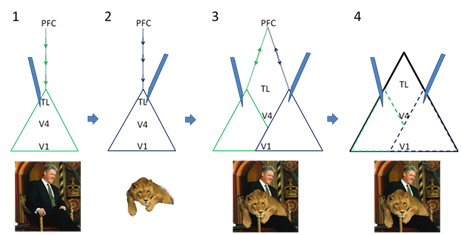
On a neurological level, mentally forming the image of Bill Clinton and the lion consists of the following steps:
Step 1 - Recall of Bill Clinton: The prefrontal cortex (PFC) activates the ensemble of neurons representing Bill Clinton to fire synchronous actions potentials. Bill Clinton is perceived by the patient. The electrode implanted into the temporal lobe (TL) records an increased rate of action potentials.
Step 2 - Recall of the lion: The PFC activates the ensemble of neurons representing the lion to fire synchronous actions potentials. The lion is perceived. The second electrode implanted into the TL records an increased rate of action potentials.
Step 3 - The patient mentally integrates the images of Bill Clinton and the lion into one scene. The Mental Synthesis Theory hypothesizes that integration is accomplished by the PFC synchronizing the two neuronal ensembles in time.
Step 4 - When synchronization of the Clinton and the lion neuronal ensembles is achieved, a new, never-before-seen mental image of Bill Clinton holding the lion on his lap is perceived by the patient. At that moment the two implanted electrodes are predicted to record synchronous action potentials, implying the synchronization of the Clinton and lion neuronal ensembles.